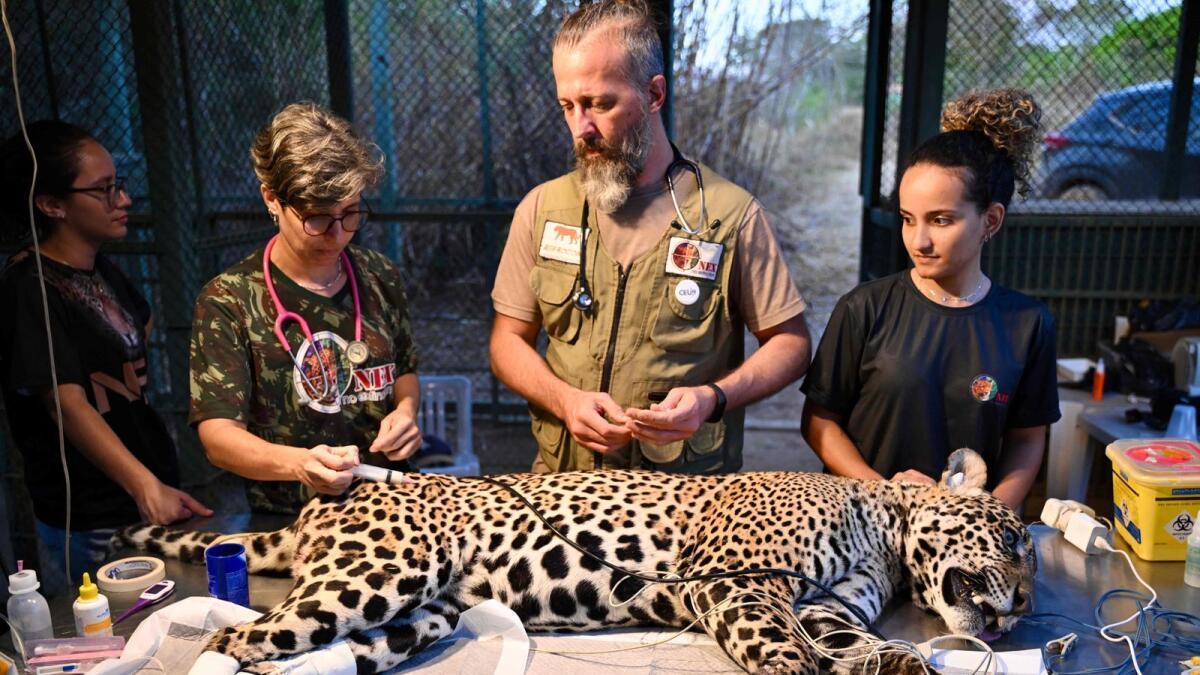
Brazil Vets Treat Jaguar Burned In Pantanal Fire
Last updated: Sun 15 Sep 2024, 8:45 PM
At a shelter for big cats in Brazil, a vet gingerly dresses wounds on a jaguar that was caught in wildfires raging in the world's largest tropical wetland.
While the animal is expected to heal, her home in the Pantanal continues to burn.
The Pantanal, south of the Amazon in Mato Grosso do Sul state, has the world's highest density of jaguars. It is also home to millions of caimans, parrots and giant otters.
Brazil has been parched by a historic drought that experts link to climate change and which has sparked what authorities have called a "fire pandemic." So far this year, some 6.7 million hectares (16.6 million acres) have burned in the Brazilian Amazon, amounting to 1.6 percent of the rainforest.
The fires are also ripping through the Pantanal, a UN World Heritage site which has recorded 1,452 fire outbreaks so far in September -- almost four times the number recorded in September 2023, according to the National Institute for Space Research.
Pollyanna Motinha, a vet at the Nex NoExtinction shelter on the outskirts of Brasilia, says she is increasingly seeing animals "at the top of the food chain, like jaguars" being injured in wildfires.
"It's not something that happened often in the past," she told AFP.
The jaguar, the largest feline in the Americas, is listed as a "near threatened" species by the International Union for Conservation of Nature.
The Pantanal jaguar, which is found along the banks of the Paraguay River, weighs on average 100 kilograms (220 pounds).
It is estimated that there are fewer than 2,000 left in the region.
The jaguar named Itapira was found hiding in a drainpipe near the town of Miranda, an area badly hit by flames. All four of her paws had been burned.
Despite her injuries the two-year-old, 57-kilogramme cat must be approached with caution.
Before being treated, she is sedated with anesthetic darts.
Motinha, her husband and fellow vet Thiago Luczinski and two students then clean her wounds and wrap her paws in bags to apply ozone, which acts as a disinfectant, as well as a healing agent.
After a month of almost daily care, Itapira's condition has improved.
In the wild, the burns prevented her from using her claws to hunt caimans and capybaras -- a large semi-aquatic rodent native to South America.
"If she had not been brought here, if she had remained in the wild, she would probably no longer be alive or would be in a deplorable state," Luczinski said.
But the caregivers worry about the jaguar's future.
"This animal is safe today but she is going to return to a region that is still burning," he said.
Another female jaguar who suffered burns in a previous major wave of fires in the Pantanal in 2020 was unable to return home from Brasilia.
Her legs were so badly burned she lost the tendons that move her claws, Silvano Gianni, co-founder of Nex NoExtinction, explained.
She went on to have two cubs in captivity -- one of whom will be reintroduced to the wild.
ALSO READ:
- AI is 'accelerating the climate crisis,' expert warns
- UAE's clean energy investments exceed Dh45 billion
- Pennsylvania's fracking industry plans to continue, whoever wins White House

Legal Disclaimer:
MENAFN provides the information “as is” without warranty of any kind. We do not accept any responsibility or liability for the accuracy, content, images, videos, licenses, completeness, legality, or reliability of the information contained in this article. If you have any complaints or copyright issues related to this article, kindly contact the provider above.






















Comments
No comment